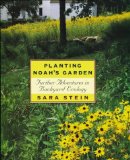| Feeling ambitious? Convert an old field to a meadow garden. |
| ABOUT US START IDEAS DO LESS USEFUL PLANTS PROJECTS VIEWS RESOURCES TOPICS |
|
|
|||
|
Question from Yvonne in Delaware: I want to return 2 acres of old farm land to meadow. How do I economically get rid of 1-2 acres of weeds and put down wildflowers and grasses? Yvonne, here's a rough idea of your options and the steps you'll probably want to take in converting your field to meadow. It will require more research into your regional plant communities, and also it will likely be a lot of work at the beginning, depending on which tools you have available. However, I don't mean to discourage you by any means; a meadow will provide you with a colorful landscape, wildlife habitat, and freedom from routine lawn chores. Know Your Region's Flora With such a large area, you will need to design a meadow that doesn't require a lot of upkeep; mowing or burning it annually should be the extent of the maintenance necessary once it's established. You'll need to set up a community of plants that don't require extra watering or fertilizing, and you'll want the desirable plants to form a thick mat that discourages weeds. First, find out what constitutes a stable meadow in your type of site. Which plants are native to your region's open areas? Much of the Eastern U.S. tends to return to forest, but there are occasional stretches of thin soil over rock, and some coastal ecosystems have few or no trees as well. The Delaware Native Plant Society can help you figure out what type of grassland ecosystem—and which grasses and wildflowers—your site will support. Native plants aren't your only options. You can also plant non-natives that aren't invasive and that fit your land's naturally occurring soil type and moisture levels. The Delaware Natural Heritage Program has compiled a list of non-native plants; you may wish to avoid those in bold-face, as they have the potential to be invasive in Delaware. Know Your Site's Flora When you've researched the desirable and undesirable plants, take an inventory. Does your field contain many desirables? Or is it full of invasives that have adapted to your location but are too unchecked to allow a mix of plants to thrive? How you proceed will probably depend on your answer. Kill Off Undesirables If your field contains mostly undesirables, you'd best kill them off before trying to establish the meadow plants. You can try this a number of ways. It may require a full year.
If, on the other hand, there are plenty of desirable plants mixed into your field along with the undesirables, you may decide to work around the desirables—hand-pulling, smothering, or poisoning the undesirables. This may be worth the effort depending on how many desirables you have and how hard they'd be to establish from seed or plugs. You'll also be able to see mature plants right away rather than starting completely from scratch. Design Your Meadow You may want to design the whole site at once, even if you plan to convert piece by piece over time. If you plan to include paths and seating areas (so that you can experience your meadow from the inside!), establish those before planting the meadow plants. If you choose the smothering option, you could even set up the paths and seating areas during the first year while you wait for the planting areas to smother. If you opt for wholesale tilling or mowing, though, you might find it easier to wait until the area is prepared before laying out any structures. Possible path materials include:
Plant Your Meadow You also have choices about how to plant your meadow. Depending on your budget and your available time and energy, you can start slow or fast. Even if you plant full-size plants, though, chances are they'll need several years to settle in and weave their roots together, so you'll need to patrol for unwanted seedlings every so often.
Finally, don't get discouraged! If you're worried that establishing or maintaining a meadow might require too much effort, why not try out the most promising technique from above on a small section of your field? This will give you a chance to play with meadow plants, a feel for the effort required, and a taste of what a larger meadow might look like. That small meadow garden might be enough for you, or it might motivate you to convert a larger piece next year. Good luck transforming your field into a lovely landscape! Please let us know what you decide to do and how it works. Evelyn Hadden Do you have a question for the LessLawn editor? |
For more information: Design a garden using your region's native grasses. Read about the rewards of a prairie garden. Check out Sara Stein's Planting Noah's Garden: Further Adventures in Backyard Ecology  |
||
|
Thanks for visiting http://www.LessLawn.com! All site contents © 2001-2013 Evelyn J. Hadden, except where noted. All rights reserved. |